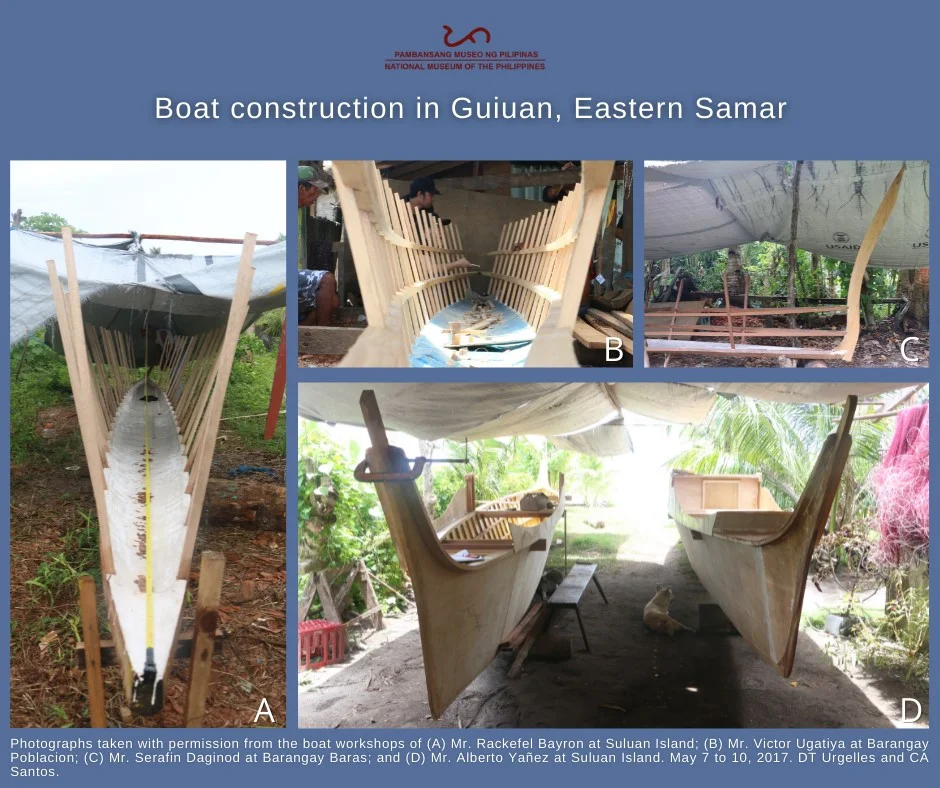Contemporary boat culture and boat-building practices at Suluan Island, Guiuan, Eastern Samar
In 2017, an interdisciplinary team from the Ethnology, Archaeology, Botany and National Herbarium, Geology and Paleontology, and Zoology divisions of the National Museum of the Philippines conducted field documentations of the cultural and natural heritage of the Municipality of Guiuan, Eastern Samar. One of the important focus areas for the project is Suluan, an island barangay. Being the easternmost island of the Visayas region, Suluan is geographically located along the usual entry point routes of typhoons. It is one of the areas critically affected by super typhoon Yolanda, internationally known as Haiyan, in November 2013.
Boat types in Guiuan, Eastern Samar
Boats are crucial for the Suluanons as their only mode of transportation to other parts of Samar and even as far as Surigao and Davao provinces in Mindanao. Suluanons, as the locals of the island refer to themselves, traditionally grow coconut and process copra as their main source of livelihood.
Boat types and Parts
 |
| Here are the main parts of the different boat types in sheer view documented in Guiuan. |
During the fieldwork in 2017, there had been a significant increase in the number of boats in Suluan due to the alternative economic plans of the local and national government units to address the effects of typhoon Yolanda. Through the Bureau of Fisheries and Aquatic Resources, Department of Agriculture and some non-government organizations, Suluanons were given small boats and were expected to turn to commercial fishing since they cannot immediately recover and return to their coconut-based economy. This also caused an influx of boat-builder migrants from Surigao del Sur who were commissioned by sponsors to build boats for the locals in Guiuan, including the Suluanons.
Boat construction
 |
| During the documentation project in 2017, all 21 boat-builders and research partners interviewed were working on pump boats. |
(A) Pump boats are built frame-first with a V-shaped hull at the bow and stern, and relatively more rounded or U-shaped at the midships. Boat-builders, predominantly men, are commissioned by boat-owners for their labor. They start boat construction by carving the keel from a single good quality timber, preferably the ‘lawaan’ or Philippine mahogany (genus Shorea), according to the preferred size of the owner.
(The keel or ‘unayan’ is also the main base or backbone of the boat where the frames, locally called the ‘ligason,’ are well secured by mortise and tenon joints. Once fitted, each joint are further secured by marine epoxy.
(C) A ‘pomarong’ is then fixed at both ends of the ‘unayan’ which extends as the prow towards the bow and the sternpost towards the stern. The ‘pomarong’ is made preferably from a single timber from the ‘hamorawon’ or ‘tugas’, also known as the molave tree (Vitex parviflora). Its shape is usually determined by the boat-maker himself and in some cases, it contains their ‘signature.’ Some are longer or shorter, while others may be more curved, depending on the preferred design or style of the builder. Generally, the prow of the pump boat is slightly higher or longer than the sternpost. It is also important to make the prow sturdy as it functions as the first line of defense at sea that enables the boat to cut across waves. Side stringers are connected directly to the ‘pomarong’ at the ‘duyong’/’dulong’ (prow) and runs longitudinally to the ‘pomarong’ of the ‘ulin’ (sternpost). These are attached to the frames by half-lap/rabbet joints.
(D) Commercially available plywood are used as planks that make up the strake of the hull. Installing the ‘batayola’ or the gunwale and completing the ‘bangkoas/ bapor-bapor/ barko-barko’ or the deck parts will follow to secure all parts of the hull. Boat-builders use non-sag epoxy for caulking and waterproofing the surface. More recently, some boat-builders use fiberglass instead of wood and timber for making boats in mainland Guiuan, but not in Suluan Island.
Installation of the outriggers or ‘katig’
The boat’s completion is signified by adding accessories such as the ‘tuladok’ or a pole set at the midships where the outriggers can be secured by nylon strings/cords to provide additional support. Boat-owners also pay special attention to painting and decorating the boat. In Suluan Island, they paint “Psalm 91” on the hull. Others print and attach a copy of the prayer near the motor pump.
The images and photographs included in this post show general information on the boat types and boat-building processes and practices shared by 21 research partners and informants from Barangays Baras, Barbo, and Suluan Island in Guiuan during the documentation project conducted from May 6 to 15, 2017. It is important to record the existing boat types in the area as changes in the context surrounding their use and production have been observed, especially in Suluan Island where boats made before 2013 were destroyed by Yolanda.
Credits:




No comments:
Got Something to Say? Thoughts? Additional Information?